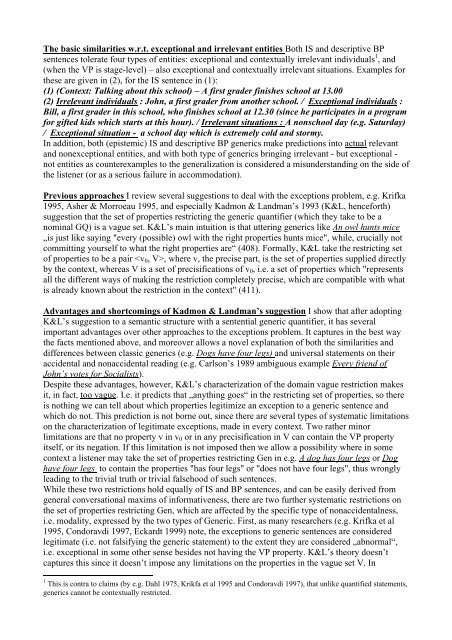SemPrag03.Progr.pdf - Institut für Linguistik/Germanistik - Universität ...
SemPrag03.Progr.pdf - Institut für Linguistik/Germanistik - Universität ...
SemPrag03.Progr.pdf - Institut für Linguistik/Germanistik - Universität ...
Create successful ePaper yourself
Turn your PDF publications into a flip-book with our unique Google optimized e-Paper software.
The basic similarities w.r.t. exceptional and irrelevant entities Both IS and descriptive BP<br />
sentences tolerate four types of entities: exceptional and contextually irrelevant individuals 1 , and<br />
(when the VP is stage-level) – also exceptional and contextually irrelevant situations. Examples for<br />
these are given in (2), for the IS sentence in (1):<br />
(1) (Context: Talking about this school) – A first grader finishes school at 13.00<br />
(2) Irrelevant individuals : John, a first grader from another school. / Exceptional individuals :<br />
Bill, a first grader in this school, who finishes school at 12.30 (since he participates in a program<br />
for gifted kids which starts at this hour). / Irrelevant situations : A nonschool day (e.g. Saturday)<br />
/ Exceptional situation - a school day which is extremely cold and stormy.<br />
In addition, both (epistemic) IS and descriptive BP generics make predictions into actual relevant<br />
and nonexceptional entities, and with both type of generics bringing irrelevant - but exceptional -<br />
not entities as counterexamples to the generalization is considered a misunderstanding on the side of<br />
the listener (or as a serious failure in accommodation).<br />
Previous approaches I review several suggestions to deal with the exceptions problem, e.g. Krifka<br />
1995, Asher & Morroeau 1995, and especially Kadmon & Landman’s 1993 (K&L, henceforth)<br />
suggestion that the set of properties restricting the generic quantifier (which they take to be a<br />
nominal GQ) is a vague set. K&L’s main intuition is that uttering generics like An owl hunts mice<br />
„is just like saying "every (possible) owl with the right properties hunts mice", while, crucially not<br />
committing yourself to what the right properties are“ (408). Formally, K&L take the restricting set<br />
of properties to be a pair , where v, the precise part, is the set of properties supplied directly<br />
by the context, whereas V is a set of precisifications of v 0 , i.e. a set of properties which "represents<br />
all the different ways of making the restriction completely precise, which are compatible with what<br />
is already known about the restriction in the context" (411).<br />
Advantages and shortcomings of Kadmon & Landman’s suggestion I show that after adopting<br />
K&L’s suggestion to a semantic structure with a sentential generic quantifier, it has several<br />
important advantages over other approaches to the exceptions problem. It captures in the best way<br />
the facts mentioned above, and moreover allows a novel explanation of both the similarities and<br />
differences between classic generics (e.g. Dogs have four legs) and universal statements on their<br />
accidental and nonaccidental reading (e.g. Carlson’s 1989 ambiguous example Every friend of<br />
John’s votes for Socialists).<br />
Despite these advantages, however, K&L’s characterization of the domain vague restriction makes<br />
it, in fact, too vague. I.e. it predicts that „anything goes“ in the restricting set of properties, so there<br />
is nothing we can tell about which properties legitimize an exception to a generic sentence and<br />
which do not. This prediction is not borne out, since there are several types of systematic limitations<br />
on the characterization of legitimate exceptions, made in every context. Two rather minor<br />
limitations are that no property v in v 0 or in any precisification in V can contain the VP property<br />
itself, or its negation. If this limitation is not imposed then we allow a possibility where in some<br />
context a listener may take the set of properties restricting Gen in e.g. A dog has four legs or Dog<br />
have four legs to contain the properties "has four legs" or "does not have four legs", thus wrongly<br />
leading to the trivial truth or trivial falsehood of such sentences.<br />
While these two restrictions hold equally of IS and BP sentences, and can be easily derived from<br />
general conversational maxims of informativeness, there are two further systematic restrictions on<br />
the set of properties restricting Gen, which are affected by the specific type of nonaccidentalness,<br />
i.e. modality, expressed by the two types of Generic. First, as many researchers (e.g. Krifka et al<br />
1995, Condoravdi 1997, Eckardt 1999) note, the exceptions to generic sentences are considered<br />
legitimate (i.e. not falsifying the generic statement) to the extent they are considered „abnormal“,<br />
i.e. exceptional in some other sense besides not having the VP property. K&L’s theory doesn’t<br />
captures this since it doesn’t impose any limitations on the properties in the vague set V. In<br />
1 This is contra to claims (by e.g. Dahl 1975, Krikfa et al 1995 and Condoravdi 1997), that unlike quantified statements,<br />
generics cannot be contextually restricted.

















